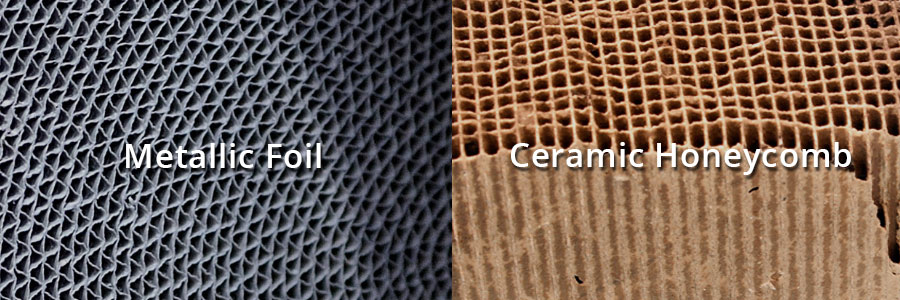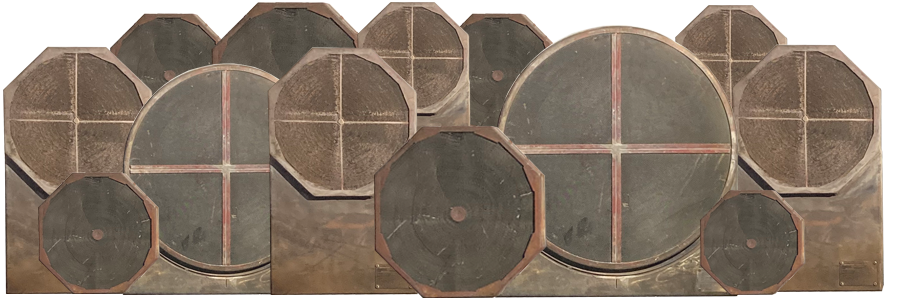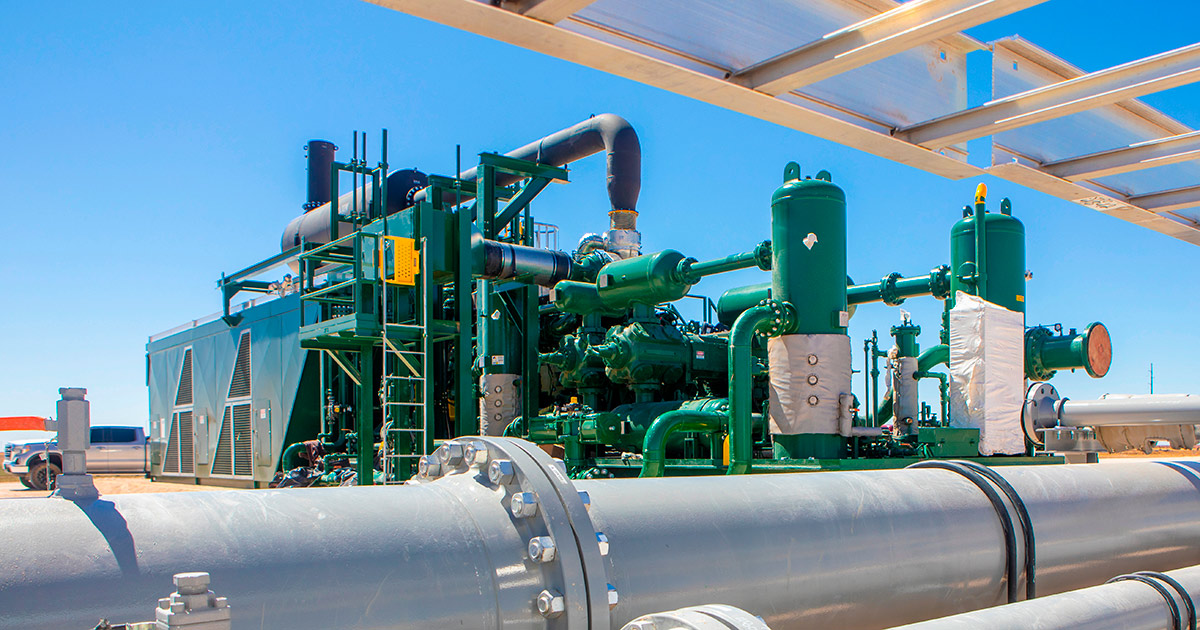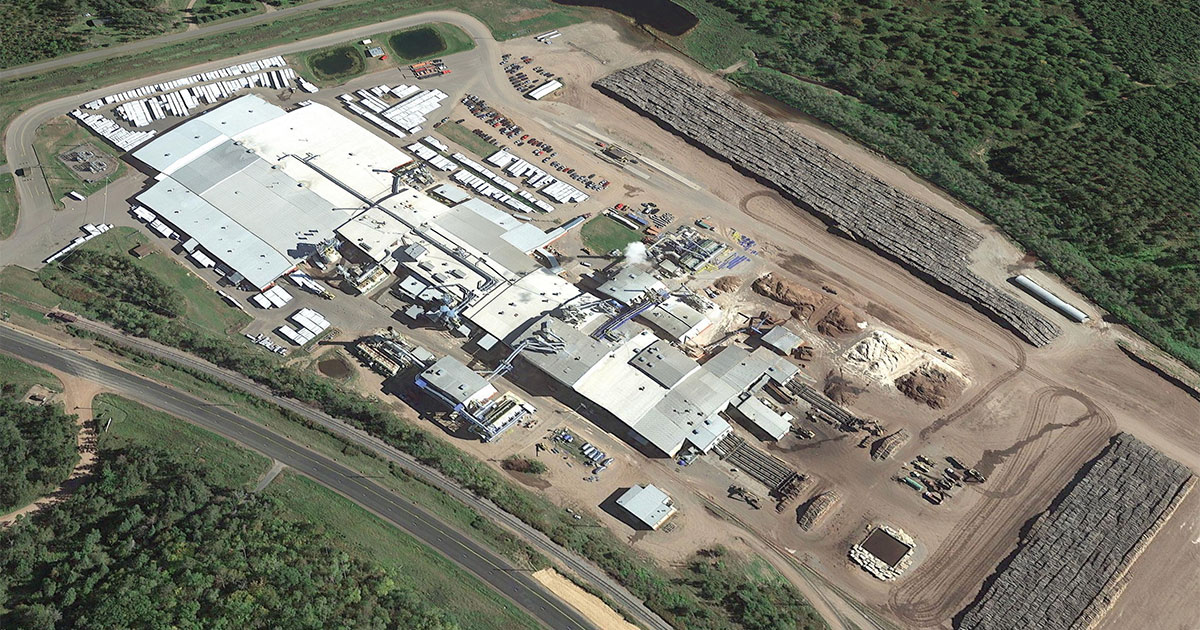Natural gas is one of the largest sources of energy production in the United States. Just under 500,000 active wells produce natural gas in the U.S. alone. With over 100 billion cubic feet of natural gas flowing from wells daily, natural gas-fired engines play a big role in the compression and transmission process.
Most natural gas-fired reciprocating engines are used in the natural gas industry at pipeline compressor and storage stations and at gas processing plants. These engines are used to provide mechanical shaft power for compressors and pumps. At pipeline compressor stations, engines help move natural gas from station to station. At storage facilities, they help inject natural gas into high-pressure gas storage fields. At processing plants, these engines are used to transmit fuel within a facility and for process compression needs (e.g., refrigeration cycles). The size of these engines ranges from 50 brake horsepower (bhp) to 11,000 bhp. In addition, some engines in service are well over 20 years old and consequently have significant differences in design compared to newer engines, resulting in differences in emissions and the ability to be retrofitted with new parts or controls.
Since 2010, stationary spark-ignited engines have been subject to National Emission Standards for Hazardous Air Pollutants for Reciprocating Internal Combustion Engines. This regulation is commonly referred to as RICE NESHAP. An element of RICE NESHAP requires that natural gas-powered engines over 500 horsepower be equipped with emission control catalysts. Like catalytic converters on cars, the catalyst on large natural gas engines contains precious metals that achieve emission reductions through chemical reactions in the exhaust. These catalysts can be recycled at the end of their useful life, and the precious metals can be reclaimed.
Why do Catalysts Get Removed from Engines?
There can be multiple reasons why catalysts get removed/replaced from engines.
- Regulatory Driven Inspections: RICE NESHAP requires that catalyst elements are checked annually to ensure the catalyst is still active and achieving the required emission reductions. Through annual source testing, if a catalyst on an engine is found to be inactive, it must be replaced.
- Planned Replacements: Because it is known that regulations will require catalyst replacements over time, many equipment operators plan on regular catalyst replacement schedules. Instead of taking the risk of a failed source test, operators may choose to replace the catalysts on a set schedule. Based on operating hours and type of equipment, these catalyst replacement intervals are generally 1-3 years.
- Catalyst Deactivation: A catalyst can theoretically last forever in a perfect world as it is never “consumed.” However, there are real-world inputs that can be introduced to a catalyst that may cause deactivation. Common causes of catalyst deactivation are:
- Contamination from engine lube oil on the catalyst
- Contamination from engine coolant on the catalyst
- Corrosion control agents used in the pipeline (i.e., phosphorus, chlorine, and sulfur compounds) can contaminate the catalyst substrate
- Excessively high engine exhaust temperatures can melt the catalyst
- Engine misfires can cause excessive pressure bursts and high temperatures that can puncture or damage the catalyst
What Types of Catalysts are Used on Natural Gas Compression Engines?
The type of catalyst used on natural gas compression engines can vary based on what pollutants you’re trying to control/reduce. The controlled pollutants can vary based on the regulations, ambient temperature, humidity, air-to-fuel ratio, ignition timing, torque, speed, and other factors.
- 3-Way Catalysts or Non-Selective Catalytic Reduction (NSCR): Used when NOx reduction is required. In addition to reducing NOx, 3-Way or NSCR can also control CO (carbon monoxide) and VOCs (volatile organic compounds).
- Oxidation Catalysts: Used when CO reduction is required.
How Does The Engine’s Air-fuel Ratio Impact Catalyst Types?
Natural gas-fired reciprocating engines are separated into two design classes driven by the engine’s air-fuel ratio: 4-stroke lean-burn and 4-stroke rich-burn. All engines in these categories are spark-ignited. The type of natural gas engine (rich burn or lean burn) will typically dictate the post-combustion catalytic technology required to meet emission requirements.
- Rich Burn Engines: Natural gas compression engines operating in rich burn environments generally use a 3-way catalyst or NSCR to control NOx, CO, and VOCs.
- Lean Burn Engines: Natural gas compression engines operating in lean burn environments generally use an Oxidation Catalyst for CO and VOC control.
What Precious Metals Are Used In Catalysts For Natural Gas Compression Engines?
The three precious metals used in natural gas compression catalysts are Platinum (Pt), Palladium (Pd), and Rhodium (Rh). These precious metals are known as Platinum Group Metals (PGM). There are several factors a catalyst manufacturer may use to determine which metal they use in a particular catalyst. It is important to know that many catalysts are custom-designed for a particular project and application. Factors that can impact what precious metal is used in a particular catalyst:
What Pollutants are Being Controlled?Platinum, palladium, and rhodium can all be used in different combinations depending on the pollutant being controlled. There is no standard rule as to what platinum group metal is used in a particular catalyst, but the combination can vary depending on whether NOx, CO, or VOCs need to be controlled.
Does the Market Price of Precious Metals Play a Role in Catalyst Manufacturing?
In certain applications, catalyst manufacturers may use platinum, palladium, or rhodium. In cases where the performance of the catalysts will not be compromised by using one metal or the other, manufacturers may choose to utilize the more affordable metal at the time.
Prices of Pt, Pd, and Rh are always changing. Currently (May 2021) Pd is about 2 times the price of Pt, however, in 2014 Pt was about 3 times the price of Pd. Current Rhodium prices are volatile, but under current conditions, they are roughly 15 – 20 times the value of Pt prices and 8 -10 times the value of Pd.
What Companies Manufacture Catalysts Used for Natural Gas Compression Engines?
Several companies make high-quality catalysts for natural gas engines. The manufacturers listed below produce catalysts for new equipment and for replacement catalysts:
- Advanced Catalyst Systems
- BASF
- Catalytic Combustion Corporation
- DCL International
- Emissions Controls and Silencers
- Johnson Matthey
- Miratech
- Precision Catalyst
- Synergy Catalyst
What do Catalysts from Natural Gas Compression Engines Look Like?
The substrate material catalysts used in natural gas compression engines are most often metallic foils. Manufacturers of catalysts used in gas compression have chosen to use metallic foil as the primary substrate as opposed to a ceramic honeycomb substrate (often used in catalytic converters for cars) because metallic foils require lower exhaust temperatures and have a lower resistance to airflow.

Image: Side by side comparison of metallic foil and ceramic honeycomb
The size and shape of the metallic foil catalysts range based on a number of factors, but they can be square, rectangular, or circular with a wide variety of housings to ensure they can fit properly in the exhaust enclosure of the engine.
Below are some photos of some common shapes of metallic foils from natural gas catalysts.

Image: Common shapes of metallic foils from natural gas catalysts
What Is the Recycle Value of a Catalyst Used on a Natural Gas Compression Engine?
Just like the types of catalysts and the combination of precious metals being used in the catalyst, the recycle value of the catalyst can vary based on several factors.
- What pollutants are being controlled (NOx, CO, VOCs)?
- What type of catalyst is being recycled?
- What is the air-fuel ratio of the engine?
- What year was the catalyst manufactured?
- How long does the manufacturer intend the catalyst to be active?
- What is the size and weight of the catalyst?
A reputable catalyst recycler should be asking all these questions to ensure an accurate price is being provided.
Given the current market conditions, Red Fox can offer some price ranges based on catalyst type:
- 3-Way Catalyst/NSCR: $6 – $30 per pound of catalyst substrate
- CO Catalysts: $0 – $15 per pound of catalyst substrate
For a quote on a specific part or application, please contact Tripp Heller directly at tr**********@*************es.com or 844-733-3695.
How do I Know How Much my Catalyst Substrate Weighs for Recycling?
Any reputable catalyst recycler will either come to your facility and weigh your material with you present or they will send a photo of your catalyst material on a certified scale with a readable display. The weight is based on the catalyst material independent of housings, enclosures, brackets, and other unrelated hardware. The payment is based on your material’s weight and the PGM’s market price.
Getting Started with Recycling Scrap Catalysts from Gas Compression Engines
If you want to recycle scrap catalysts or other emission control parts, please visit our contact page or call 844-733-3695.
References & Resources
- U.S. Energy Facts from EIA
- RICE NESHA (National Emission Standards for Hazardous Air Pollutants for Reciprocating Internal Combustion Engines)
- EPA Stationary Sources: 3.2 Natural Gas-fired Reciprocating Engines




